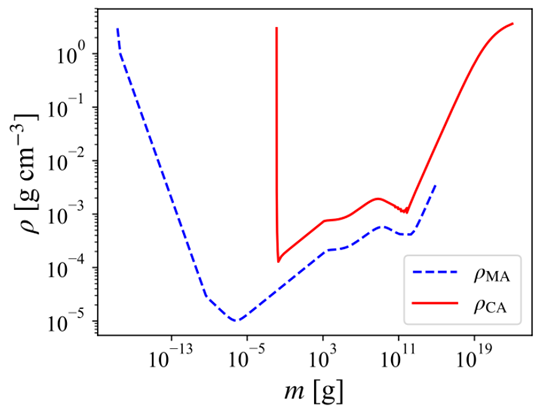研究成果藝廊 > 理論天文物理理論天文物理
(Theory)
研究成果藝廊
理論天文物理理論天文物理
(Theory)
| Formation of chondrite meteorite parent body |
|
圖片來源: Matsumoto et al.

The evolution paths of aggregates are plotted in the mass-density diagram.
|
The growth of chondrules and matrix in a dense clump is calculated. The evolution paths of aggregates are plotted in the mass-density diagram. These are two kind of aggregates, which are the aggregates purely composed of matrix grains (hereinafter called MAs) and chondrule-matrix compound aggregates (CAs, see also Ormel et al., 2008; Arakawa 2017).
These are two kind of aggregates, which are the aggregates purely composed of matrix grains (hereinafter called MAs) and chondrule-matrix compound aggregates (CAs, see also Ormel et al., 2008; Arakawa 2017).The blue dashed line is that of MA. At first, the density of a MA decrease due to hit-and-stick growth, and a MA becomes fluffy. Then, the MA is compressed by ram pressure or self-gravity. This is typical evolution of fluffy dust (Kataoka et al., 2013, Arakawa & Nakamoto 2016).The red solid line is the evolution of CA. A chondrule grows up by collisions with MAs, and a CA is formed. Due to the collisions between a CA and MAs, a CA is composed by a chondrule and fluffy matrix component, and the density of a CA becomes very small. After the timescale of CA-CA collision is shorter than that of CA-MA, CA-CA collisions occur. The mass of a CA increases largely in this stage. Since CAs accrete MAs again at 4 x 10^{10} g, the evolution line of a CA is jagged. After this stage, a CA is compressed as its mass increases by CA-CA collisions. Then, a chondrite parent body is formed by collisions (Matsumoto et al., in preparation). |
 asiaa.sinica.edu.tw 媒體連絡: epo
asiaa.sinica.edu.tw 媒體連絡: epo asiaa.sinica.edu.tw
asiaa.sinica.edu.tw